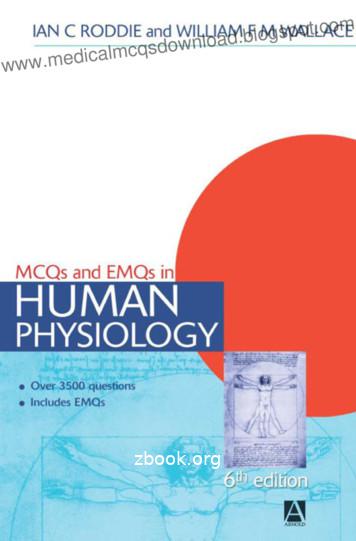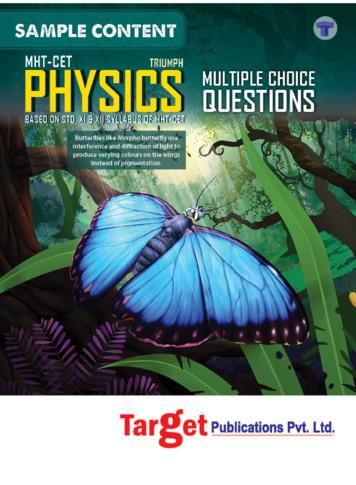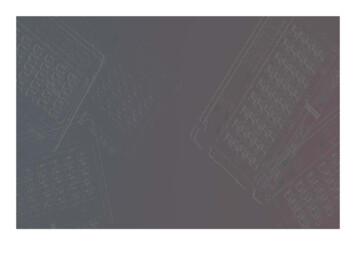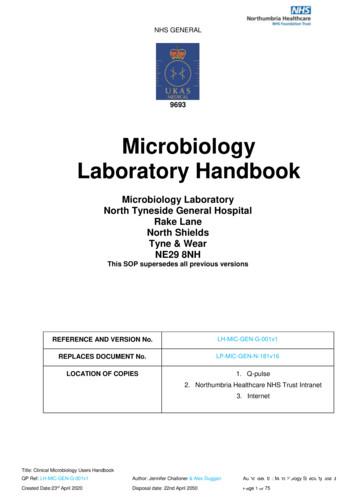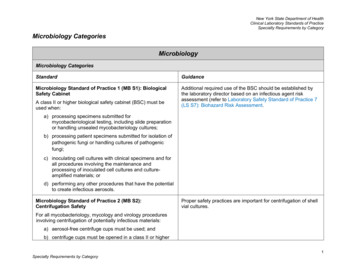MCQs In Microbiology
This pageintentionally leftblank
Copyright 2008, New Age International (P) Ltd., PublishersPublished by New Age International (P) Ltd., PublishersAll rights reserved.No part of this ebook may be reproduced in any form, by photostat, microfilm, xerography,or any other means, or incorporated into any information retrieval system, electronic ormechanical, without the written permission of the publisher. All inquiries should beemailed to rights@newagepublishers.comISBN (13) : 978-81-224-2931-2PUBLISHING FOR ONE WORLDNEW AGE INTERNATIONAL (P) LIMITED, PUBLISHERS4835/24, Ansari Road, Daryaganj, New Delhi - 110002Visit us at www.newagepublishers.com
This book is dedicated toPROF. B.G. SHIVANANDAPrincipalAl-Ameen College of PharmacyPharmacyBANGALOREFor his Herculean efefforforts in bringingHerculeanfortsAPTI to a high pedestal
This pageintentionally leftblank
FOREWORDMultiple choice questions (MCQs) test a candidates ability to apply his or her knowledge acquired during theregular course of study. Framing a question paper based on MCQs is time consuming but evaluating the answers iseasy.subjectiveness of the examiner associated with evaluation of essay type of answers is inherent in the evaluationprocess & depends upon several variables such as hand writing, methods of presentation etc. These variables do notexist during evaluation of answers based on MCQs.I am of the opinion that for the examination system at the undergraduate level, the entire testing of theoreticalknowledge should be MCQ based since the evaluation can be computerized & human bias can be largely eliminated.In this book, the multiple choice questions have been prepared with great care such that the questions framed areprecise & clear enabling the reader to make correct choices. A wide coverage of topics is given.I strongly recommend this book for all related to Microbiology & College Libraries.PROF DR. KANTI GORVice ChancellorK.S. K. V. Kachchh UniversityBhuj, Gujarat
This pageintentionally leftblankVisit StudyFrnd.com Formore pdfs and alleducation materials
PREFACEThe book is primarily meant for students appearing for PG competitive examinations. In USMLE, GATE, AFMC,AIIMS & other Medical, Paramedical entrance examinations for admissions to PG Programme, Microbiology is one ofthe important component of the syllabus.The main objective of this book is to help students to review their knowledge of Microbiology acquired throughstandard textbooks. A sound knowledge of Microbiology is essential for students of Medicine, Pharmacy, Dentistry &Nursing for understanding the subject with logical reasoning. This book is specially designed to complement anystandard microbiology textbook and to provide the students with a feedback on their progress & an opportunity toimprove. Thus the book can serve as a self assessment guide.With the explosion of knowledge in medical sciences, examinations in all faculties (Medicine, Pharmacy, Dentistry& Nursing) is completely becoming MCQ oriented because this system of assessment is more accurate, reliable &quicker. A welcome trend in this direction is already discernibleBoth the teachers & students of microbiology will find this book useful. A quick persuation of the questions willprovide evidence that the book intends to stimulate reasoningSuggestions & criticism about the book are welcome.G. Vidya Sagar
This pageintentionally leftblank
ACKNOWLEDGEMENTSIt gives me pleasure to acknowledge with deep appreciation for all those who have extended their co-operationduring the preparation of the book. Prof. Dr. B. SureshPresident, Pharmacy Council of India Sri. Harish PadhDirector, Sri B.V. Patel PERD centreAhmedabad, Gujarat Prof. Dr. Ajay K. SalujaA.R. College of PharmacyVallabh VidyanagarGujarat Dr. E. Bhanoji RaoPrincipal, Rolland Institute of Pharmaceutical SciencesBehrampur, Orissa Dr. K. Senthil KumarPrincipal, Padmavathy College of PharmacyDharmapuri, TamilnaduFinally, I express my gratitude to Mr. Soumya Gupta, MD, Manager, New Age International (P) Limited, New Delhi,for his encouragement and support.- Author
This pageintentionally leftblank
CONTENTSPrefaceChapter 1HISTORY OF MICROBIOLOGYChapter 2BACTERIA & GRAM STAININGChapter 3STERILISATION, CULTURE MEDIA & PURE CULTURE TECHNIQUESChapter 4GENERAL PROPERTIES OF MICROORGANISMSChapter 5BACTERIAL NUTRITIONChapter 6BACTERIAL GROWTHChapter 7STRUCTURE OF DNA & RNAChapter 8IMMUNOLOGYChapter 9MEDICAL MICROBIOLOGYChapter 10INDUSTRIAL MICROBIOLOGY(ix)192533373945516177
This pageintentionally leftblank
CHAPTER 1HISTORY OF MICROBIOLOGY1. According to Pasteur statements whichone of the following is truea. Living organisms discriminate betweenstereoisomersb. Fermentation is a aerobic processc. Living organisms doesn’t discriminatebetween stereoisomersd. Both a and b2. “I found floating therin earthly particles,some green streaks, spirally woundserpent-wise, and orderly arranged, thewhole circumstance of each of thesestreaks was abut the thickness of a hairon one’s head” . These words are ofa. Leeuwenhoekc. Pasteurb. A. Jennerd. Koch3. The principle light- trapping pigment molecule in plants, Algae, and cyanobacteriaisa. Chlorophyll ac. Porphyrinb. Chlorophyll bd. Rhodapsin4. During Bio Geo chemical cycle someamount of elemental carbon was utilizedby the microorganisms. The phenomenon is called Neutralization5. Who demonstrated that open tubes ofbroth remained free of bacteria when airwas free of dust.a. Abbc Spallanzani b. John Tyndallc. Francisco Redid. Pasteur6. Reverse isolation would be appropriatefora.b.c.d.aaaapatient with tuberculosispatient who has had minor surgerypatient with glaucomapatient with leukemia7. The symptome “ general feeling of illnessand discomfort “ is calleda. Cystitisb. Malaisec. Anaphylactic shockd. Arthritis8. On soybean which of the following formssymbiotisma.b.c.d.Azatobactor paspaliRhizobiumNostocBradyrhizobium9. Who provide the evidence that bacteriophage nucleic acid but not protein enters thehost cell during infectiona.b.c.d.Alfred D.Hershey & Leonard Tatum in 1951.Alfred D.Hershey & Zindar Lederberg in 1951.Alfred D.Hershey & Martha Chase in 1952.Alfred D.Hershey & Macleod in 1952.
MCQs IN MICROBIOLOGY10. Spirulina belongs toa. Xanthophyceaec. Rhodophyceaeb. Cyanophyceaed. Pheophyceae11. The first antibody to contact invadingmicroorganisms wasa. IgGc. IgAb. IgMd. IgD12. The light emitted by luminescent bacteriais mediated by the enzymea.b.c.d.Coenzyme QLuciferaseLactose dehydrogenaseCarboxylase reductase13. Pick out the vector using in humanGenome projecta.b.c.d.Phagemid vectorYeast artificial chromosomesCosmid vectorsYeast episomal plasmids14. Salt and sugar preserve foods becausetheya.b.c.d.Make them acidProduce a hypotonic environmentDeplete nutrientsProduce a hypertonic environment15. In a fluorescent microscope the objectivelens is made ofa. Glassc. Polytheneb. Quartzd. None of these16. Fixation of atmospheric nitrogen is bymeans ofa. Biological process b. Lightiningc. Ultraviolet lightd. All of the above17. Which one of the following fungi is themost serious threat in a bone marrowtransplant unit?a. Candida albicans b. Aspergillusc. Blastomycesd. Cryptococus18. Direct microscopic count can be done withthe aid ofa. Neuberg chamber b. Anaerobic chamberc. Mineral oild. Olive oil19. The image obtained in a compoundmicroscope isa. Realc. Real invertedb. Virtuald. Virtual inverted20. Enzymes responsible for alcoholicfermentationa. Ketolasec. Peroxidaseb. Zymased. Oxidase21. Which type of spores are produced sexually?a. Conidiac. Ascosporesb. Sporangiosporesd. None of these22. Bacterial transformation was discoveredbya.b.c.d.Ederberg and TatumBeadle and TatumGriffithNone of these23. Father of microbiology isa. Louis Pasteurb. Listerc. A.V. Leeuwenhock d. Robert Koch24. The antiseptic method was first demonstrated bya. Lwanowskic. Edward Jennerb. Lord Listerd. Beijerinck25. Small pox vaccine was first discovered bya. Robert Kochc. Listerb. Louis Pasteurd. Edward Jenner26. The term mutation was coined bya. Pasteurc. Hugo devriesb. Darwind. Lamark27. Compound microscope was discovered bya. Antony vonc. Johnsen & Hansb. Pasteurd. None of these28. Father of Medical Microbiology isa. Pasteurc. Kochb. Jennerd. A.L.Hock29. Disease that affects many people atdifferent countries is termed asa. Sporadicc. Epidemicb. Pandemicd. Endemic
!HISTORY OF MICROBIOLOGY30. Prophylaxis of cholera isa.b.c.d.Protected water supplyEnvironmental sanitationImmunization with killed vaccinesAll of these31. In electron microscope, what material isused as an objective lense?a.b.c.d.Magnetic coilsSuperfine glassAluminium foilsElectronsAbsence of locomotionAbsence of nuclear envelopeAbsence of nuclear materialAbsence of protein synthesis33. The stalked particles on the cristae ofmitochondria are calleda. Glyoxysomesc. Oxysomesb. Peroxisomesd. Spherosomes34. Antiseptic methods were first introducedbya. Lord Listerc. Beijernickb. Iwanowskid. Edward Jenner35. Kuru disease in Humans is caused bya. Bacteriac. Prionsb. Viroidesd. Mycoplasma36. A mutation that produces terminationcodon isa.b.c.d.Mis-sense mutationNeutral mutationNon-sense mutationReverse mutation37. During conjunction the genetic materialwill be transferred througha. Cell wallc. Pilib. Mediumd. Capsule38. Antiseptic surgery was discovered bya. Joseph Listerc. Pasteura.b.c.d.Water borne diseaseAir borne diseaseFood borne diseaseAtthropod borne disease40. Phagocytic phenomenon was discovered bya. Louis Pasteurc. Metchnikofb. Alexander Flemingd. Robert Koch41. Meosomes are also known as32. The main feature of prokaryotic organismisa.b.c.d.39. Tuberculosis is ab. Ernest Abbed. Beijerinka.b.c.d.MitochondriaEndoplasmic reticulumPlasmidsChondroids42. Hybridoma technique was first discoveredby.a.b.c.d.Kohler and MilsteinRobert Koch‘D’ HerelleLand Steiner43. The minimum number of bacteriarequired to produce clinical evidence ofdeath in a susceptible animal understandard condition is calleda. LD50c. MLDb. IDd. All of these44. In Electron Microscope source of electronsis froma. Mercury lampc. both a and bb. Tungsten metald. None of these45. Griffith (1928) reported the phenomenonof transformation first ina. H. influenzaec. Pneumococcib. Bacillus speciesd. E.coli46. The resolution power of the compoundmicroscope isa. 0.2 micronb. 0.2 millimeterc. 0.2 Angstrom units d. 0.2 centimeter47. The capacity of a given strain of microbialspecies to produce disease is known asa. Pathogenc. Infectionb. Virulenced. None of these
"MCQs IN MICROBIOLOGY48. Monoclonal antibodies are associatedwith the name ofa. Burnetb. Medwarc. Milstein kohlerd. Owen49. Lederberg and Tatum (1946) describedthe phenomena ofa. Conjunctionb. Transformationc. Mutationd. Plasmids50. Hanging drop method for motility studywas first introduced bya. Robert Kochc. Jennerb. Louis Pasteurd. Leeuwenhock51. Electron microscope gives magnificationuptoa. 100 Xc. 50,000 Xb. 2000 Xd. 2,00,000 X52. Term vaccine was coined bya. Robert Kochc. Needhamb. Pasteurd. None of these53. The inventor of Microscope isa. Galileoc. Pasteurb. Antony vond. Koch54. First Pasteur conducted fermentationexperiments ina. Milkc. Fruit juicesb. Food materiald. Both a and c55. Modern concepts of chemotherapy wasproposed bya. Paul Ehrlichc. Elie Metchnikoffb. Joseph Listerd. None of these56. The role of phagocytosis was discoveredbya. Paul Ehrlichc. Elie Metchikoffb. Joseph listerd. Pasteur57. L – forms are discovered bya. Klein Bergerb. Louis Pasteurc. Robert Kochd. Antony von Leeuwenhock58. The causative organism of rocky mountainspotted fever was first described bya. Howard Rickettsc. Both a and bb. da Rocha-limad. Robert Koch59. The term bacteriophage was coined bya. De’Herellec. Beijernickb. F.W. Twortd. Jwanosky60. Viral infection of bacteria was discoveredbya. De’Herellec. Beijernickb. F.W. Twortd. Jwanoksy61. Eye cannot resolve any image less thana. 1ìmc. 7ìmb. 2ìmd. 5ìm62. Compound Microscope was discovered bya. A.V. Lewenhoek b. Pasteurc. Janssen and Hans d. None of these63. Electron Microscope was discovered bya. Prof. Fritzc. Knoll and Ruskab. Janssen and Hansd. None of these64. Magnification range of light microscope isa. 1000x – 5000xc. 500x – 1000xb. 1000x – 2000xd. None of these65. Condensation of light in light Microscopeis bya. Objectivec. Ocularb. Condensord. All of these66. Light gathering capacity of Microscope iscalleda. Numerical aperture b. Angular aperturec. Both a and bd. None of these67. If 10x and 40x objectives are used (air isthe medium), the numerical aperture isa. 1.5c. 1.0b. 2.0d. 1.868. The ability of Microscope to distinguishtwo objects into two separate objects, iscalled.a. Resolving powerc. N.A.b. Wave lengthd. None of these
#HISTORY OF MICROBIOLOGY69. Limit of resolution of compound microscope isa. 0.018 Aoc. 5 ìmb. 0.1 mmd. 1 mm70. Source of light in fluorescence microscopyis froma. Mercury lampc. Both a and bb. Sunlightd. None of these71. Who perfected a magnetic lens in 1927a. Gaborc. Buschb. Broglied. None of these72. The magnefication power of electronmicroscope developed by Knell andRuska isa. 10,000xc. 15,000xb. 12,000xd. 20,000x73. In electron microscope source of electronsis froma. Mercury lampc. Both a and bb. Tungsten metald. None of these74. The electron passed out from thespecimen are calleda. Primary electrons b. Secondary electronsc. Tertiary electrons d. None of these75. Mycorrhiza was first observed bya. Funkc. Fisherb. Frankd. Crick76. The transfer of genetic material duringtransformation is proved basing onGriffith’s experiment bya.b.c.d.Avery Macleod & Mc.CarthyLederberg & TaulumZinder & LederbergWatson & Crick77. Phagocytic theory was proposed bya. Louis Pasteurc. Behringb. Elie Metchnikoffd. Widal78. Anaphylaxia was first observed bya. Parter & Richetc. Gellb. Coombsd. None of these79. Primary mediators in anaphylaxisa. Histaminec. Heparinb. Seratonind. All of these80. Arthus reaction was discovered bya. Marrice Arthusc. Richetb. Von Perquitd. Porter81. Serum sickness reaction was discoveredbya. Marrice Arthusc. Richetb. Von perquitd. Porter82. Hybridoma technique was developed bya. Kochler & Milston b. Niel’s Jernec. Both a and bd. None of these83. Disease that effects many people atdifferent countries is termed asa. Sporadicc. Epidemicb. Pandemicd. Endemic84. If the vectors transmit the infectionmechanically they are calleda.b.c.d.Biological vectorsMechanical vectorsBiological reservoirBoth a and c85. If a person can be infected by directcontact with infected tissue of anotherperson, it is termed asa.b.c.d.Indirect contact transmissionAttachmentDirect contact transmissionNone of these86. Reduction of virulence is known asa. Exaltationc. Both a and bb. Attenuationd. None of these87. Enhancement of virulence is known asa. Exaltationc. Both a and bb. Attenuationd. None of these88. The virulence of a pathogen is usuallymeasured bya. LDc. IDb. MLDd. All of the above
MCQs IN MICROBIOLOGY89. The lethal dose required to kill 50% of thelab animals tested under standard calleda. IDc. ID50b. LD50d. MLD90. The most important virulence factors area. Adhesionsc. Toxigenicitye. All of the aboveb. Invasivenessd. Enzymes91. The ability of a pathogen to spread in thshost tissues after establishing theinfection is known asa. Adhesionc. Toxigenicityb. Invasivenessd. None of these92. Which is the following enzyme acts as aspreading factor?a. Hyaluronidasec. Catalaseb. Coagulased. DNase93. Vibrio Cholerae was discovered bya. Kochc. John Snowb. Metchnikoffd. Virchow94. E.coli was first isolated bya. Louis Pasteurc. Shigab. Escherichd. Robert Koch95. Mycobacterium tuberculosis was firstdiscovered bya. Robert Kochc. Louis Pasteurb. Edward Jennerd. None of these96. Mycobacterium lepree was discovered bya. Robert Kochc. Edward Jennerb. Hansend. Louis Pasteur97. Streptococcus pneumoniae was isolatedbya.b.c.d.Robert KochEdward JennerAntony von LeewenhockLouis Pasteur98. B.anthracis was isolated bya.b.c.d.Louis PasteurRobert KochAntonyvon LeewenhokNone of these99. Staphylococcus aureus was isolated bya.b.c.d.RosenbachLouis PasteurPassetSir Alexander Ogston100. Pseudomonas aeruginosa was firstnameda.b.c.d.Schroeter and GessardRobert KochLouis PasteurEdward Jenner101. T. pallidum was discovered bya.b.c.d.Robert KochSchaudinn and HoffmanLouis PasteurEdward Jenner102. Neisseria gonorrhoeae was first describedbya. Neisser in 1879c. Robert Kochb. Pasteur in 1878d. None of these103. Rh factor of the blood was discovered byscientista.b.c.d.e.Louis PasteurLandsteiner and WeinerJanskeyMossNone of these104. Trepanema pallidum was discovered bya.b.c.d.e.Schaudinn and HoffmanLouis PasteurBurgeyLaennecNone of these105. Fluroscent substance used in fluorescentmicroscopy area. Quinine sulphate b. Auraminec. All of thesed. None of these
%HISTORY OF MICROBIOLOGYANSWERS1. a7. b13. b19. b25. d31. a37. c43. c49. a55. a61. d67. c73. b79. d85. c91. b97. d103. b2. a8. d14. d20. b26. c32. b38. a44. b50. d56. c62. c68. a74. b80. a86. b92. a98. b104. a3. a9. c15. c21. c27. c33. b39. b45. c51. d57. a63. c69. b75. b81. b87. a93. b99. b105. c4. b10. b16. d22. a28. c34. a40. c46. a52. b58. c64. b70. a76. a82. c88. d94. b100. a5. b11. b17. b23. c29. b35. c41. d47. b53. b59. a65. b71. a77. b83. a89. b95. a101. b6. a12. c18. a24. b30. b36. c42. a48. a54. c60. b66. a72. b78. a84. b90. e96. b102. b
This pageintentionally leftblank
CHAPTER 2BACTERIA AND GRAM STAINING1. Cold like symptoms are caused by whichbacteria7. The functions of plasmid area. DNA replicationa. Pseudomonasb. Protein synthesisb. E.colic. Cell wall synthesisc. Haemophilus influenzad. None of the aboved. Haemophilus streptococcus2. In Streptococcus fecalis, the conjugationtakes place at8. Mycoplasmas are bacterial cells thata. Fail to reproduce on artificial meidab. Have a rigid cell walla. Pilib. Cell membranec. Are resistant to penicillinc. Cell walld. Flagellad. Stain well with Gram’s stain3. The infected mad dogs may contain9. The etiologic agent of botulism is aa. Nergi bodiesb. Niagri bodiesa. Neurotoxinb. Endotoxinc. Negri bodiesd. Neisser bodiesc. Enterotoxind. All of the above4. What disease the Nesser will produce?a. Mumpsb. Rubellac. Poliod. Measles5. Rancidity in spoiled foods is due toa. Lipolytic organismsb. Proteolytic organisms10. The bacterial cells are at their metabolicpeak duringa. Lag phaseb. Logc. Stationaryd. Decline11. Protein particles which can infect arecalledc. Toxigenic microbesa. Vironsb. Prionsd. Saccharolytic microbesc. Nucleoidad. None of these6. The Baterium that is most commonly usedin genetic engineering is12. In most of purple bacteria, the lightharvesting centers area. Escherichiab. Klebsiellaa. B 850 & Fe-Sb. B 850 & B 875c. Proteiusd. Serratiac. B 845 & B 875d. B 850 & B830
MCQs IN MICROBIOLOGY13. Endotoxin produced by gramnegativebacteria is present ina. Peptidoglycanc. Theichoic acidb. Lippolysacharided. Inner membrane14. Which one of the following was Gramnegative, chemolithotrophic bacteria?a. Siderococcusc. Spirellumb. E.colid. Mycoplasms15. The mode of reproduction which occursin mycoplasma isa. Buddingc. Binary fissionb. Burstingd. Binary fusion16. Which one of the following is aboutHerpes viruses?a.b.c.d.Icosahedral, with envelope, ds DNAPolyhedral with envelope, ds DNARNA, helical with envelopeds DNA, brick shape17. Which one of the following producetypical fried egg appearance colonies onsolid media?a. Mycobacteriac. Mycoplasmsb. Mycoplastsd. Bacteroides18. An organism that is osmophilic and hasa specific requirements for sodiumchloride resemblesa. Halophilec. Barophileb. Basophiled. Xerophile19. A population of cells derived from a singlecell are calleda. Monclonal cellsc. Protoplastsb. Clonesd. Sub culture20. Hetrolactic acid bacteria producea.b.c.d.LacticLacticLacticLacticacid onlyacid H2O CO2acid CO2acid alchohol CO221. In which
HISTORY OF MICROBIOLOGY. 30. Prophylaxis of cholera is. a. Protected water supply b. Environmental sanitation c. Immunization with killed vaccines d. All of these. 31. In electron microscope, what material is used as an objective lense? a. Magnetic coils b. Superfine glass c. Aluminium foils d. Electrons. 32. The main feature of prokaryotic .
MCQs 261-330 115 EMQs 331-340 139 6 Special senses MCQs 341-384 149 EMQs 385-394 163 7 Urinary system MCQs 395-434 171 EMQs 435-444 185 8 Endocrine system MCQs 445-501 193 EMQs 502-512 211 9 Reproductive system MCQs 513-567 219 EMQs 568-576 237 l0. General questions MCQs 577-639 245 EMQs 640-649 265 11 Sport and exercise physiology MCQs 650-686 .
MHT-CET Syllabus. Exhaustive subtopic wise coverage of MCQs. Notes, Shortcuts, Mindbenders, Formulae provided in each chapter. Various competitive exam questions updated till the latest year. Includes MCQs from NEET 2016, 2017 and 2018. Includes MCQs upto MHT-CET 2018. Evaluation test provided at the end of each chapter.
An Introduction to Clinical Microbiology Susan M. Poutanen, MD, MPH, FRCPC . Objectives 1. To provide an introduction to a typical microbiology laboratory 2. To address specific microbiology laboratory test issues as they apply to public health. Department of Microbiology Who we are Shared microbiology service between TML (UHN & MDS) and MSH
Industrial microbiology Medical and pharmaceutical microbiology Rumen microbiology Space microbiology 1.2 Definitions Milk and milk products occupy a more significant role in the human food profiles. The study of microorganisms that are associated with milk and milk products in all aspects is defined as "Dairy Microbiology". 1.2 .
General Microbiology Manual _ Abdelraouf A. Elmanama Ph. D Microbiology 7 Introduction Welcome to the microbiology laboratory. The goal of the laboratory is to expose students to the wide variety of lives in the microbial world. Although the study of microbiology includes
Title: Clinical Microbiology Users Handbook QP Ref: LH-MIC-GEN-G-001v1 Author: Jennifer Challoner & Alex Duggan Authorised by: Microbiology Specialty board Created Date:23rd April 2020 Disposal date: 22nd April 2050 Page 1 of 75 9693 Microbiology Laboratory Handbook Microbiology Laboratory North Tyneside General Hospital Rake Lane North Shields Tyne & Wear NE29 8NH This SOP supersedes all .
Microbiology H Core 4 3 30 70 100 4 MBH- 204 Food Microbiology H Core 4 3 30 70 100 4 MBS- 205 Bioinformatics S Core 2 2 15 35 50 2 Practical MBP- 206 Microbial Genetics, Molecular Biology Pract 4 4 30 70 100 4 MBP- 207 Environmental Microbiology and Food Microbiology Pract 4 4 30 70 100 4
Microbiology Categories. Microbiology . Microbiology Categories Standard . Guidance; Microbiology Standard of Practice 1 (MB S1): Biological . Additional required use of the BSC should be established by the laboratory director

